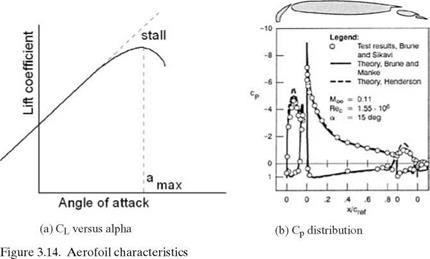Definitions of Aerodynamic Parameters
Section 3.4 defines Re and describes the physics of the laminar/turbulent boundary layer. This section provides other useful nondimensional coefficients and derived parameters frequently used in this book. The most common nomenclature – without any conflicts on either side of the Atlantic – are listed here; it is internationally understood.
Let q2 = 1/2p V2 = dynamichead (3.21)
(The subscript 2 represents the free streamflow condition and is sometimes omitted.) ‘q’ is a parameter extensively used to nondimensionalize grouped parameters.
The coefficients of the 2D aerofoil and the 3D wing differ, as shown here (the lowercase subscripts represent the 2D aerofoil and the uppercase letters are for the 3D wing).
2-D aerofoil section (subscripts with lowercase letters):
Cl = sectional aerofoil-lift coefficient = section lift/qc Cd = sectional aerofoil-drag coefficient = section drag/qc (3 )
Cm = aerofoil pitching-moment coefficient ^ ‘
= section pitching moment/qc2(+ nose up)
3D wing (subscripts with uppercase letters), replace chord, c by wing area, SW:
CL = lift coefficient = lift/qSW
CD = drag coefficient = drag/qSW (3.23)
CM = pitching-moment coefficient = lift/qSW(+ nose up)
Section 3.14 discusses 3D wings, where correction to the 2D results is necessary to arrive at 3D values. Figure 3.13 shows the pressure distribution at any point over the surface in terms of the pressure coefficient, Cp, which is defined as follows:
|
|












